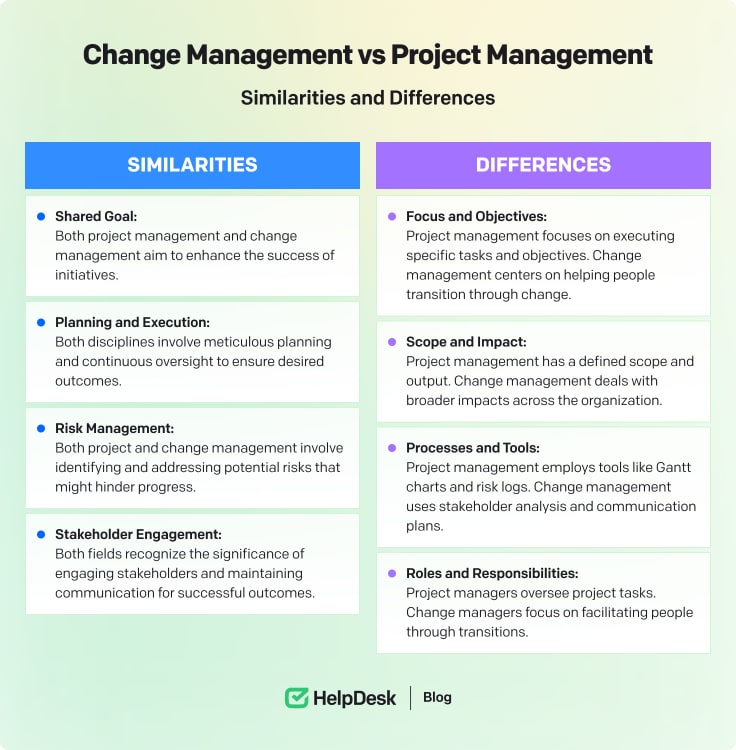Frustrated by constant workflow disruptions or struggling to keep your team motivated? Do you feel overwhelmed by the challenge of meeting customer expectations while managing daily tasks? How can you balance operational performance with outstanding customer service?
Becoming a successful service desk manager involves more than overseeing daily tasks; it’s about mastering leadership, utilizing advanced technology, and fostering a culture of continuous improvement.
Let’s explore some key strategies and insights that will help you navigate the complexities of this role.
Building a high-performing service desk team
Establishing a solid foundation built on well-defined roles, a balanced mix of skills, and a strong team culture is important to create a service desk team that consistently delivers results.
Here’s how to structure your team and provide the necessary training and development for long-term success.
Team structure and roles
1. Define clear roles and responsibilities
Each team member should have specific duties and expectations aligned with their skills and the service desk’s objectives. Clearly defining these roles ensures everyone understands their responsibilities and can contribute to the team’s performance.
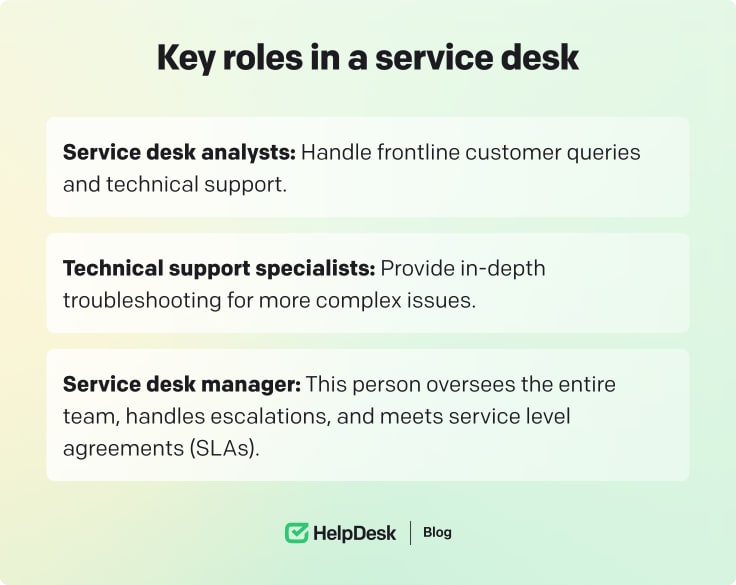
2. Establish a hierarchical structure
A well-structured hierarchy with a clear chain of command is essential for effective decision-making. It streamlines communication and simplifies the escalation process. When team members know who to approach for assistance or guidance, delays in problem-solving are minimized, allowing the service desk to function smoothly and efficiently.
3. Build a diverse skill set
A prosperous service desk team needs more than technical expertise. Ensure your team has a blend of:
-
Technical skills to troubleshoot software and hardware issues.
-
Business acumen to understand the broader impact of IT issues on the company.
-
People skills to handle customer interactions with empathy and professionalism.
This balance ensures that your team can resolve technical issues and provide excellent service desk performance, keeping users satisfied and operations running smoothly.
If you're unsure whether your team has all the necessary skills, check out our Learning Space lesson about customer service skills. 🚀

4. Foster a collaborative culture
Creating a positive and inclusive work environment maximizes the team’s potential. A culture encouraging open communication, collaboration, and knowledge-sharing leads to greater efficiency and a more supportive atmosphere. Team members who feel valued and included are likelier to contribute innovative ideas and work together effectively.
Training and development
1. Provide ongoing training opportunities
Offering regular training sessions on new software, emerging technologies, and customer service best practices keeps your team’s technical and business skills sharp. Whether through in-house training programs, online courses, or external certifications, continuous learning helps maintain the team’s expertise in service desk operations.
Enhance your customer experience with a well-trained support team. 🦸 Learn everything with HelpDesk and boost your customer satisfaction. 🔥

2. Continuous learning and industry awareness
Motivate your team to stay updated with industry trends and service desk innovations. Encourage certifications and participation in industry forums or conferences. It ensures your service desk staff can implement new strategies and tools to improve service performance.
3. Offer mentorship programs
A mentorship program can help new hires integrate into the team more quickly. Pairing new employees with experienced service desk managers allows them to learn the ropes and gain confidence in their roles. Mentors can provide guidance on technical tasks and company culture, accelerating the onboarding process.
4. Recognize and reward good performance
Acknowledge individual and team achievements by rewarding top performers. Public recognition, bonuses, or professional development opportunities can boost morale and inspire your team to maintain a high level of performance.
Service desk operations
Service management is a must for delivering consistent, high-quality support to end users. To achieve this, you need well-established procedures that govern how incidents, problems, and changes are managed.
Also, using knowledge management and continuous process refinement can ensure that operations run smoothly while adapting to the business’s evolving needs.
Processes and procedures
Establishing standardized processes is the backbone of any successful service desk management. Your team can handle requests systematically, reducing downtime and increasing customer satisfaction.
1. Procedures for incident, problem, and change management
Service desks should have structured processes for handling specific situations, ensuring a consistent approach across the team.
-
Incident management focuses on quickly resolving service disruptions to minimize user impact.
-
Problem management addresses the root causes of recurring incidents to prevent future issues.
-
Change management ensures the smooth implementation of new systems or updates with minimal service disruption.
Check out the list of the best change management software in 2024. 🚀
2. Maintain a service catalog
A service catalog is a structured list of all services the service desk provides, making it easier for end users to request support. The catalog should include descriptions of each service offered, information on how to access each service, and expected response and resolution times.
A well-maintained service catalog simplifies the service request process, improves user experience, and ensures the IT service desk manager can handle requests efficiently.
3. Knowledge management system
A knowledge management system is essential for capturing and sharing expertise within the team. By documenting solutions to common issues, best practices, and troubleshooting tips, the team can quickly resolve similar issues in the future.
This system should be:
-
Regularly updated to reflect new information.
-
Easily searchable so that team members can access relevant information quickly.
-
Accessible to all team members, promoting knowledge-sharing across the organization.
4. Review and refine processes
Service desk operations should not remain static. Regularly reviewing and updating processes ensures they remain relevant and efficient as the business grows or technology changes.
Conduct periodic assessments of incident resolution times, user feedback, and team performance to identify bottlenecks or areas where the process could be improved.
Incident and problem management
Incident management protocols ensure that issues are resolved promptly and that root causes are addressed to prevent recurring disruptions.
1. Incident management process
A well-defined incident management process ensures that user issues are handled efficiently and that disruptions to services are minimized.
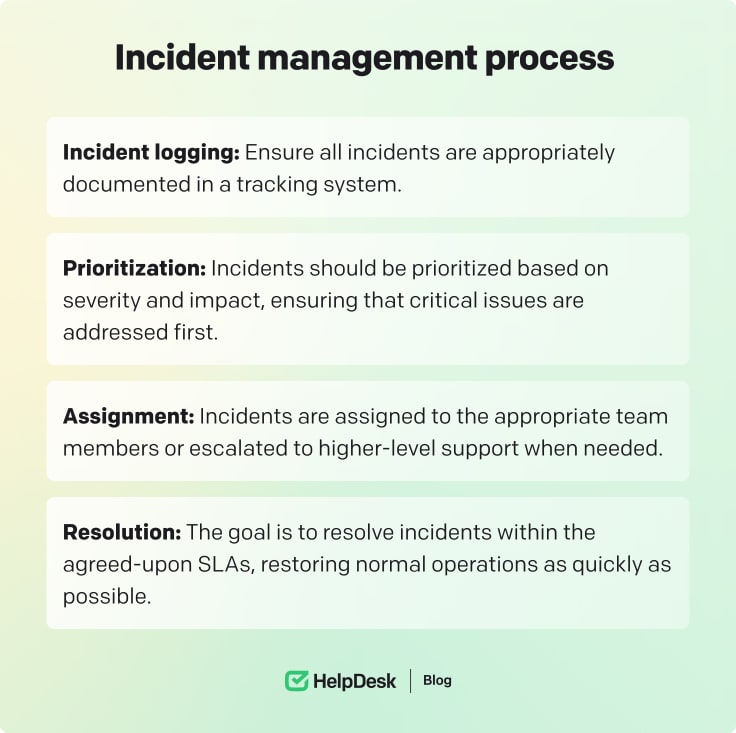
2. Problem management process
While incidents are focused on immediate fixes, problem management addresses the root causes behind incidents. It aims to identify the underlying issues and prevent them from recurring.
It typically involves:
-
Problem identification: Analyzing patterns and data to identify recurring incidents that may indicate a more significant problem.
-
Root cause analysis (RCA): Investigating the problem’s origin to find the root cause.
-
Permanent solutions: Developing and implementing long-term solutions to resolve the root cause and prevent future incidents.
3. Change management process
The change management process changes systems, applications, or infrastructure to prevent service disruptions. The process includes:
-
Risk assessment: Evaluating the potential risks associated with the change.
-
Approval workflows: Ensuring relevant stakeholders approve changes before implementation.
-
Testing: Testing changes in a controlled environment to prevent errors during the rollout.
-
Communication: Informing users of upcoming changes and any potential impact on their services.
The process helps avoid unintended consequences of changes, such as system downtime or degraded performance. It also allows the organization to adapt and improve its IT service desk team and infrastructure.
Service desk performance
To improve service desk performance, you should measure performance using clear metrics and regularly review service levels.
Measuring success
-
Establish clear key performance indicators (KPIs): Define metrics such as first-call resolution rate, mean time to resolve (MTTR), and customer satisfaction scores to measure performance effectively.
-
Gather feedback: Conduct surveys to collect user feedback and pinpoint improvement areas for excellent customer service.
-
Data and analytics: Analyze trends and performance data to identify and address improvement areas.
Gathering feedback is not an easy task to do. Learn how to do it properly with the HelpDeak Learning Space. 🧑🚀
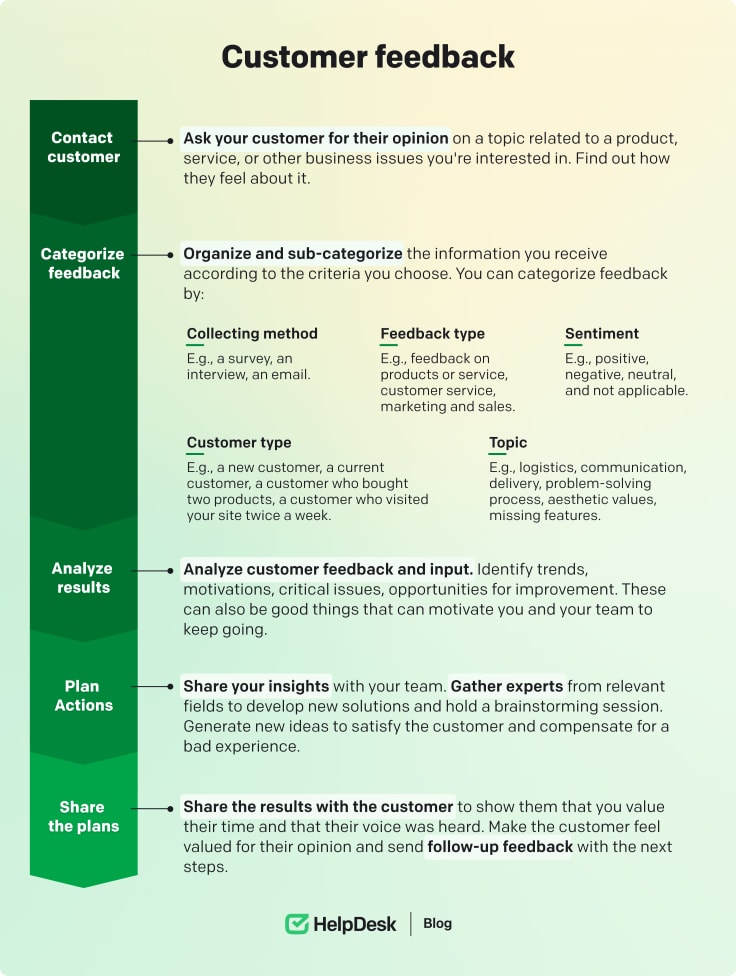
Service level agreements and KPIs
Service level agreements (SLAs) play a crucial role in aligning business objectives with customer expectations and ensuring that service levels meet agreed-upon standards. Regular reviews and refinements of SLAs and KPIs are essential to maintaining their relevance and effectiveness in a dynamic business environment.
Benchmarking performance against industry standards provides valuable insights into competitiveness, helping to identify best practices and opportunities for improvement.
These strategies create a solid foundation for delivering consistent and high-quality service.
Effective communication and stakeholder management
Communication strategies
You need to follow a few steps to create a perfect plan:
-
Develop a communication strategy: Create a comprehensive plan that outlines how information will be shared with stakeholders, including objectives, methods, and frequency.
-
Utilize multiple channels: Engage stakeholders through various communication channels such as email, phone, and in-person meetings to ensure messages are received and understood.
-
Clarity and timeliness: Communicate concisely and deliver messages promptly to maintain engagement.
-
Monitor communication effectiveness: Use data and analytics to evaluate the success of communication efforts, identifying which channels and methods are most effective.
Stakeholder management
Identifying and engaging key stakeholders, including customers, business leaders, and IT teams, is essential to understanding their needs and expectations. Building strong relationships begins with developing a stakeholder management plan that outlines engagement strategies, communication protocols, and collaboration methods.
By tracking stakeholder satisfaction through data and feedback, you can pinpoint areas for improvement and strengthen relationships. Regularly reviewing and refining the management plan ensures it stays relevant and adapts to evolving needs. Proactive engagement fosters trust and supports exceptional customer service by anticipating and addressing concerns before they escalate.
Industry practices and frameworks
IT service management frameworks
Adopt a framework like the Information Technology Infrastructure Library (ITIL) to align service desk operations with industry best practices and standards. It ensures that service desk operations are standardized and aligned with best practices, improving support services.
-
Guide operations with ITIL**:** Use the framework to structure and enhance service desk processes, aiming to improve service delivery consistency and quality.
-
Integrate with IT Systems: Check that the ITIL framework is compatible and integrated with other IT systems and tools, facilitating seamless operations and data flow.
-
Ongoing refinement: Regularly evaluate and update the ITIL framework to ensure it meets organizational needs and adapts to industry changes and advancements.
Career development and professional growth
Invest in career development and provide growth opportunities. Service desk managers will be well-equipped to advance in their careers and contribute effectively to improved business operations.
-
Establish career progression: Create a structured career path for service desk managers that outlines potential growth opportunities, roles, and responsibilities and provides a clear trajectory for advancement.
-
Offer continuous training: Training and development programs can improve technical skills, business acumen, and soft skills, ensuring that service desk managers remain proficient and adaptable.
-
Promote learning: Encourage ongoing education and professional development to keep pace with industry trends, emerging technologies, and best practices so that managers stay current and competitive.
-
Recognize performance: Acknowledge and reward exceptional performance and contributions to inspire and motivate service desk managers. It’ll build a positive work environment and promote excellence.
-
Encourage networking: Facilitate opportunities for managers to connect with industry peers and participate in professional communities to expand their network and gain insights from others in the field.
Make customer service easier with HelpDesk — all your customer communication in one simple dashboard. Join today! 🚀
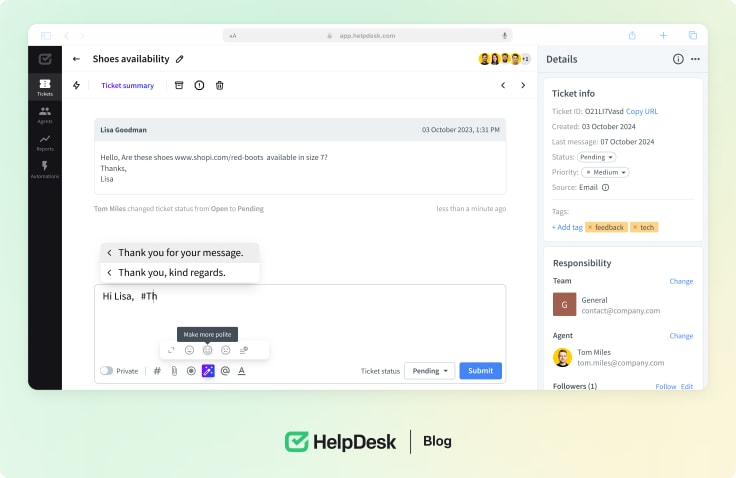
Summary
Becoming a successful service desk manager requires a blend of strategic vision, effective leadership, and a commitment to continuous improvement. You must focus on transparent processes, use the latest technology, and foster a collaborative team environment.
A tool like HelpDesk can significantly simplify this journey. Its comprehensive features, such as ticket management, issue resolution, and asynchronous communication, ensure that every customer interaction is logged, tracked, and addressed efficiently.
The platform’s automation and AI capabilities streamline repetitive tasks, freeing up valuable time for your team to focus on complex issues and proactive outreach. You can integrate it into your operations and empower your team to manage all customer messages in one place.

